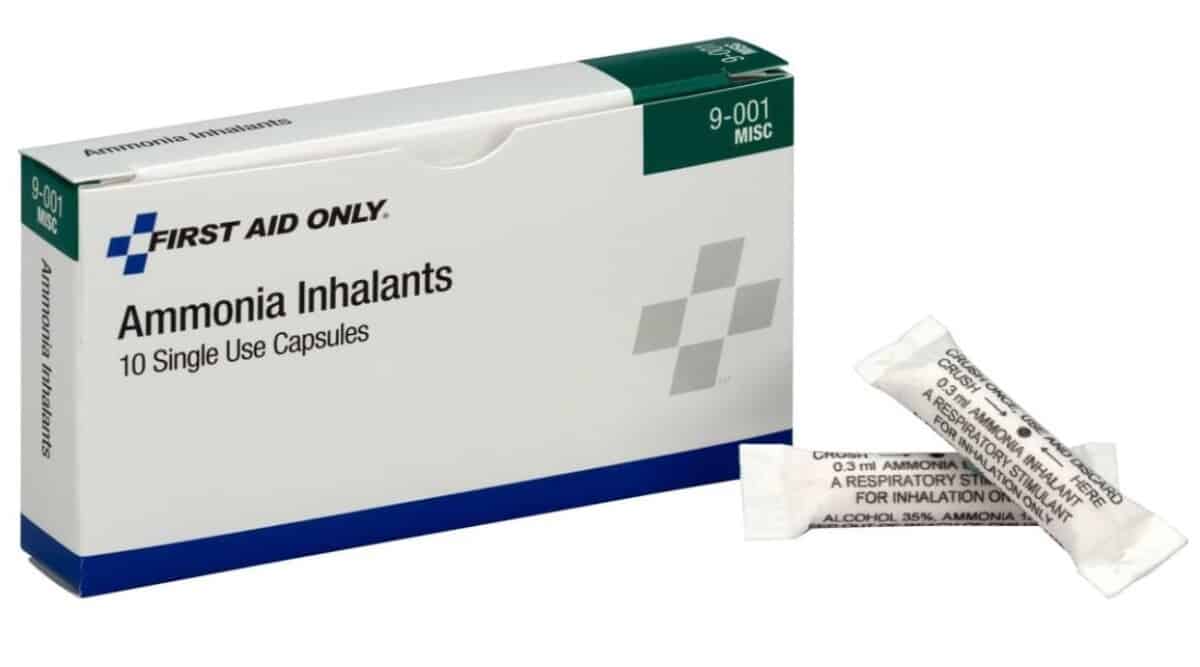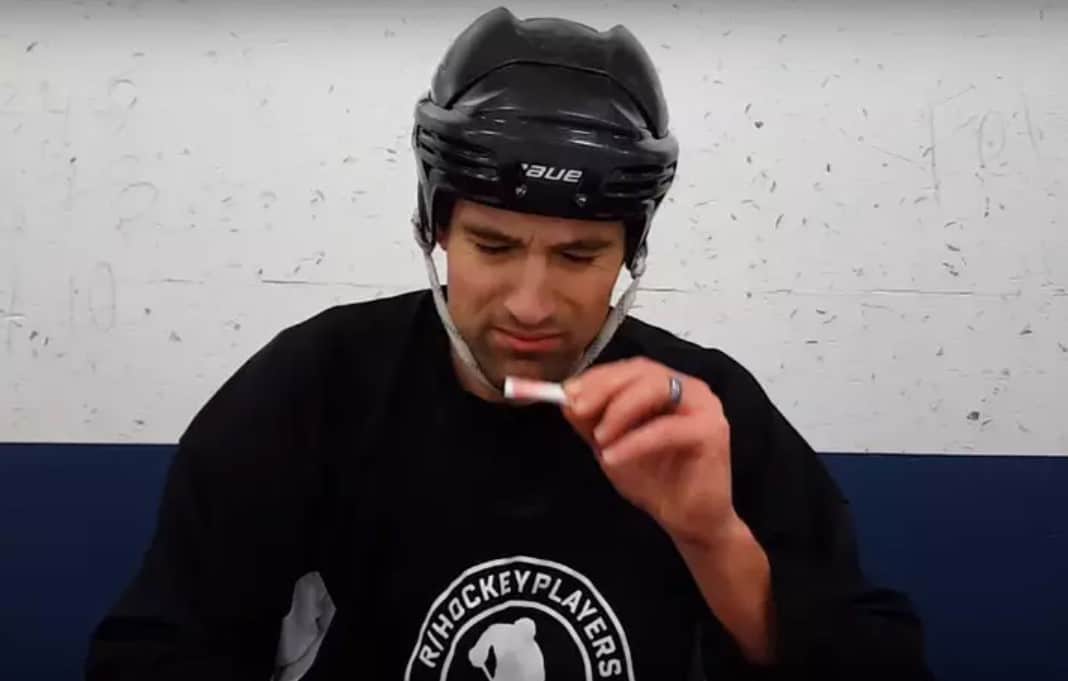As the national anthem concludes, the camera zooms in on players getting ready to take the ice. You see them hold something close to their nose and breath in: What is that?
Hockey players sniff smelling salts to help them focus and increase motor skills during play. Smelling salts are used across hockey and other sports to engage the lungs quickly, causing the athletes to breathe faster. This allows hockey players to be alert as soon as they get on the ice.
Some people argue that smelling salts are all hype and no results. Let’s find out what smelling salts are all about. At least watch people inhale them for the first time!
What are Smelling Salts?
Smelling salts are small packets of chemicals that produce a scent and when inhaled, a person’s lungs starting pumping faster. Athletes, among many other people, use these smelling salts to stimulate their body before performing. NHL hockey players can be seen smelling the little packages right before the puck drops.
Smelling salts are used in many different situations: war times, athletic competitions, medical situations, and anytime someone has fainted. The goal is to get the person to focus and alert their lungs and brain that we need to start working harder. Since it is an involuntary reaction when your nose catches the scent of the smelling salt, it is a good way to get someone engaged and paying attention.
If you have ever smelled something and you felt like your nose hairs were on ‘fire,’ it is a very similar sensation. At the core smelling salts are made of ammonia and perfume. Nitrogen and Hydrogen are combined to make ammonia, the main ingredient in smelling salts used by hockey players, medical professionals, and trainers.
If you want forgo trying them on your own and instead want to see how the professional react, take a look at this video.
If you want to see people that do not know exactly what is about to hit them take a crack at smelling salts…
Bottom line- No matter if you are a professional and have taken a few sniffs of smelling salts or have no idea what is about to hit you, the scent hits you hard, hence why medical professionals use it to wake someone up if they have passed out.
History of Smelling Salts
The earliest known existence of smelling salts dates back to the Roman era. Medical personnel would use sharp aromas like smelling salts to wake up patients after a procedure, to ensure they were still alive. Women were known to carry ammonia with their personal belongings. If they were about to pass out, they could quickly grab the container and snap back to it.
“In the 17th century an aqueous solution of ammonia (also called aquila coelestis) was obtained from the distillation of shavings of harts’ horns and hooves. When crystallised, this chemical turned out to be ammonium carbonate and was initially called salt (or spirit) of hartshorn and later became known as smelling salts when mixed with perfumes. It is also known as “baker’s ammonia” and was a forerunner to the more modern leavening agents such as baking soda and baking powder.”
McCrory, P. “Smelling salts.” British journal of sports medicine vol. 40,8 (2006): 659-60. doi:10.1136/bjsm.2006.029710
Another commonplace for smelling is war. Not in current warfare, but back in the early to mid-1900’s it was carried by all medical staff. You have probably seen it used in war movies. When soldiers got seriously wounded, doctors needed them to stay awake. If the soldier was about to pass out from the pain, medics would crack open smelling salts to keep the soldier alert.
Dr. Joe Schwarcz, who has a Ph.D. in Chemistry from McGill University, explains how smelling salts were discovered, how they were used throughout history, and what are common uses for smelling salts today. At the end of the video, he brings in one of his assistants to smell ammonia for the first time. Great reaction!
Why do Athletes Use Smell Salts?
After sweating for a few minutes, you feel more engaged and ready to play whatever activity you are doing. Maybe you do a few stretches, take a lap to “get the blood flowing.” All these activities have been preached all your life to help get your body ready to perform.
Smelling salts are used in the same mindset, but the goal is to get your body there quicker. Professional sports are not organized well from a process standpoint. You would think they would operate pregame activities to produce the most smooth and natural way to warm up and start the event.
As stated above, you get your body stretched out and start warming up. Your brain and heart are on the same wavelength. Ok, we need to start pumping blood faster, lungs we need more air in here. Every part of the body is on the same page.
That warm-up process happens in sports, and then what is next? Well, you would think through grabbing a small squirt of water and jumping into action. Nope. The whole team goes back to the locker room for a set period of time, maybe 20-30 minutes before they start playing. Crazy. The last thing you want to do is your body to cool down and everything to start moving slower, but that is what happens.
After they come back from the locker room, the anthem is sung, and a few minutes later the game starts.
Insert smelling salts here. When the athletes are finally allowed to step in and play, they need to be at peak awareness, thus they jump-start their body with smelling salts. Their muscles are warm, but they need something to tell their lungs, let’s roll!
Are Smelling Salts Bad for You?
In small doses, smelling salts are not bad for you. If you watched the video from earlier in the article, you can see the packets are very small. This design is for a reason, as large amounts of smelling salts can cause damage.
According to the British Journal of Sports Medicine, there is a low risk of getting injured while using smelling salts.
“While there are numerous case reports of the toxicity of ammoniacal agents when ingested in large doses or inhaled in high concentration for prolonged periods there are, in fact, no reports of adverse health problems related to the use of smelling salts in sport.”
McCrory, P. “Smelling salts.” British journal of sports medicine vol. 40,8 (2006): 659-60. doi:10.1136/bjsm.2006.029710
I have read many sports medicine articles regarding the good and bad of smelling salts, and the general thought is all neutral. They are not going to hurt you unless you shove many ounces into your nose or administer the salts to someone with a head or neck injury. The smells will cause them to move their head/neck without control thus further injuring the person. It is common knowledge not to move someone with these kinds of injuries.
On one side of the conversation, they say the salts will not enhance your athletic performance. Many athletes ignore this advice and smell the odor during games anyways. Some believe it helps their performance, others smell out of superstition and habit.
How Long Do Smelling Salts Last?
Smelling salts themselves only last a few seconds. Think about spraying perfume or cleaner into the air. You smell it for a short period, and then it goes away. Like any smell, as soon as it is released, it dissipates into the air. They are not dangerous like natural gas that can get into your body and cause severe damage to your lungs.
How long do the side effects of smelling salts last? Now that is a different question. It is not like taking medicine where side effects last 6- 12 hours and the drugs remain in your body for a few days. Remember, you are getting the attention of the sensors in your nose, not injecting something into your body system. Smelling salt only lasts a few seconds.
Are Smelling Salts FDA Approved?
Yes, smelling salts are FDA approved, but only recommended use is for people that have fainted and do not have a head, neck, or back injury. They do not mention any coloration between smelling salts and an increase in athletic performance. If you are the scientific type or enjoy research articles, here is a 7-page article published by The American Society of Excercise Physiologists explaining data-backed results of not finding an increased performance by smelling ammonia.
Medical News Today published an article explaining the ammonia mixture provides such a jolt to your sensory cells in your nose, you want to use in small doses. Do not breathe in several times while holding the smelling salt package close to your nose. As always when putting something into your body, talk to a doctor before using smelling salts.
Should I Let My Kid Use Smelling Salts?
I am not a doctor, so please consult one before making a decision. With all the research I have done, many medical resources caution against younger athletes using smelling salts. When comparing most medicine/ supplements doses between kids and adults, kids are always less. You never want to put your kid’s body into overdrive, forcing them to go through something their body might not be ready to handle.
Yes, you will see those parents are kids tournaments giving their kids a smell of salts right before a game; don’t be those parents. Please.
Where Can I Buy Smelling Salts?
You can buy smelling salts anywhere on the internet. You do not need a prescription for the purchase. It is interesting to note, a lot of the salts come in first aid kit packaging.
Here are a few examples where you can buy online. These packets should only cost $10-$15.
First Aid Only– Check price on Amazon here.

Ward Smelling Salts– Check price on amazon here.

Can You Make Homemade Smelling Salts?
There is a reason some of the packaging comes in a first aid kit form- do not try at home! Not to imply there is any danger, but anytime you are mixing chemicals, I would enter with caution. Most of the recipes out there will not contain ammonia, the main chemical that packs a punch in the smelling salts you can buy from Amazon or a supplement store online.
WikiHow has a receipt you can follow. It is an alternative to the traditional smelling salt formula. They even recommend leaving the real stuff up to the chemists in the lab. There are recipes that you can find on forums- do you want to make a recipe for a product you found on Reddit or another forum that you will inhale?
What Else Are Smelling Salts Used For?
We talked through some of them at the beginning of the article, but here is a list of things smelling salts were originally intended for:
- Medical Reasons– when people experience pain (surgery or bad injury), medical staff would administer smelling salts.
- Fainting Fits-Back in the day (way back), some people were prone to passing out, so they would carry smelling salts with them.
- Baking Soda- A very similar formula is used in baking soda.
How do You Use Smelling Salts?
If you get anything from this article, it is smelling salts should be used with caution. All products will come with specific instructions, so read them carefully before using.
General rules are: hold the smelling salts 4-6 inches away from your nose, and take a normal breath in, and then remove the smelling salts from your nose. That is it. Simple steps and you are ready to go crush the opponent.

